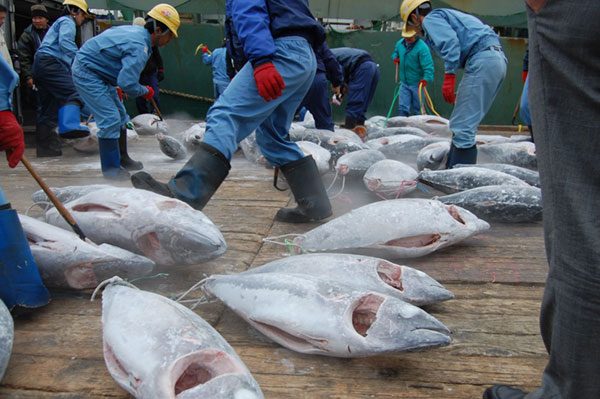
Apart from fish sticks, which kids happily devour, seafood is always thought to be better fresh than frozen. That is true if it’s locally caught, flown in from a day-boat dock, or kept alive in tanks, like lobster. But tuna travels several thousand miles to reach these shores. And whether it is flown to New Jersey chilled but fresh or shipped here frozen, two or three weeks can elapse from hook to table.
Uoriki Fresh, a Secaucus-based, Japanese-owned company, is having success persuading chefs and now consumers—its tuna is available at all Whole Foods Markets in New Jersey except Princeton—that minus-76 degree Fahrenheit “superfrozen” tuna is fresher than fresh. Uoriki (the name means, “the power of fish”) has one of just a handful of superfreezers in North America.
“In conventional freezing, at minus 10 to 20 degrees, decomposition continues, just at a slower pace,” says Michael McNicholas, Uoriki’s sales and marketing executive and quality control manager. “At minus 76, the fish enters what is essentially a state of suspended animation. When you thaw it, time restarts. Nothing happens in between.”
Some tuna is gassed with carbon monoxide, which turns the meat a lasting, bright, watermelon red but does not retard the way of all flesh. At supermarket counters and sushi stands, gassed tuna should be labelled as such but is not always. The bright color is falsely reassuring, because it is no gauge of freshness.
Superfreezing was originally developed in the United States in the late 1960s for preserving medical samples. In the ’70s, the Japanese adapted it to tuna, and now 80 percent of all tuna consumed in Japan as sushi and sashimi is superfrozen.
I recently took a tour of Uoriki’s storage facility with a few chefs, food-supply executives, and food writers. Cloaked in thin white lab coats and hair nets, and exhaling frozen breath trails, we braved a walk into the baleful, thudding grayness of the 50-ton-capacity superfreezer. Afterward we were revived from our shudders by hot tea and a sushi and sashimi banquet.
The thawed superfrozen yellowfin, bigeye, and bluefin maguro (meaning, simply, tuna) we feasted on were indistinguishable from the best fresh sashimi I’ve had at top restaurants in New Jersey and New York—from the prized marbled pink belly meat (toro) to the standard red lean cut (akami). We also sampled superfrozen yellowtail (hamachi), a plush sushi-bar favorite that is technically amberjack rather than tuna.
Chef Edward Higgins of restaurant Insiemé in New York, who used to live in Japan, said of the superfrozen yellowtail, “It tastes more like it does in Tokyo. In the United States a lot of yellowtail tastes overfattened, but this has more acidity, a tang, and better texture.” He later became a Uoriki customer.
In New Jersey, superfrozen tuna is on the menu as sushi or as seared steaks at 22 restaurants, including the Brass Rail in Hoboken, Genta in Ridgewood, Josho in Somerset, Komegashi Too in Jersey City, Mitsuba in Chatham, Mega Sushi in Cherry Hill, Sawa in Long Branch, and Masa in Allendale. Whole Foods is the exclusive retail outlet in the country for superfrozen tuna from Uoriki. Defrosting is this simple: a quick soak in warm salted water, a freshwater rinse, swaddling in paper towels, and three to six hours in the fridge.
Superfreezing begins at sea, where tuna are gilled, gutted, and lowered into high-tech freezers within 20 to 40 minutes of being hauled from the deep. In about eight to fifteen hours, depending on size, the fish’s core temperature reaches its eutectic point, or EP—the temperature at which all cellular activity and microbial decomposition absolutely cease.
From the hold of the fishing vessel to Uoriki’s Secaucus sanctum to restaurants (which pack it in dry ice) and Whole Foods seafood departments (which are equipped with small superfreezers from Uoriki), the fish are kept at minus 76 degrees. Off-loaded at processing facilities in Japan or Korea, the tuna are cut with bandsaws into all-meat 8- to 30-pound loins. Months may pass before the boxed loins reach the United States by ship and arrive at Uoriki in the Meadowlands. But not a second has passed on their biological clocks.
Here’s a tip from Uoriki general manager Ken Kawauchi, a 35-year veteran of the seafood industry who has been importing superfrozen tuna for a decade.
“Sushi is finger food,” he says. “Don’t use chopsticks. Don’t use too much soy sauce, and always dip with the fish side down, not the rice side.”
In his own connoisseurship, Kawauchi is way past sushi. His favorite delicacy is tuna eyeballs. Don’t be weirded out. “You eat only the white part of the eye,” he says reassuringly. “It’s like pudding.”



